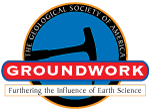Abstract View
GSA Today
Article, pp. 42–43 | Full Text | PDF (161KB)
 |
| Search GoogleScholar for Search GSA Today |
GROUNDWORK:
Moving lithospheric modeling forward: Attributes of a community computer code
1 Washington State University, School of the Environment, PO Box 624812, Pullman, Washington 99164-2812, USA
2 University of Idaho, Dept. of Geological Sciences, 875 Perimeter Drive, MS 3022, Moscow, Idaho 83844-3022, USA
3 University of Alberta, Dept. of Physics, Edmonton, Alberta, Canada T6G 2E1
4 New Mexico Institute of Mining and Technology, Dept. of Earth & Environmental Science, 801 Leroy Place, Socorro, New Mexico 87801, USA
5 University of California Davis, Earth and Planetary Sciences, Computational Infrastructure for Geodynamics, 2215 Earth and Physical Sciences, One Shields Avenue, Davis, California 95616, USA
6 Arizona State University, School of Earth & Space Exploration, P.O. Box 876004, Tempe, Arizona 85287-6004, USA
We live on a planet with an active surface that is modified and deformed at multiple temporal and spatial scales owing to diverse processes occurring at plate boundaries and plate interiors. The processes of mid-ocean-ridge spreading, mountain building, subduction of tectonic plates, mantle drag, intra-continental deformation, earthquakes, and volcanism cross traditional disciplinary boundaries (Fig. 1A). Understanding these lithospheric processes is valuable not only for intellectual curiosity and to refine our working knowledge of plate tectonics, but also for understanding threats to life, property, and infrastructure. Computer modeling and simulation are increasingly powerful tools that researchers employ to better understand lithospheric deformation and unravel the complex feedbacks that drive the evolution of Earth’s surface. The field is poised for a significant advance to take advantage of recent expansions in computing power, improved representation of idealized processes, increased data availability, and better communication between software developers and geoscientists.
Manuscript received 28 Aug. 2014; accepted 2 Dec. 2014
doi: 10.1130/GSATG230GW.1
